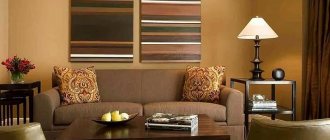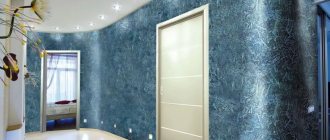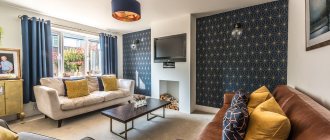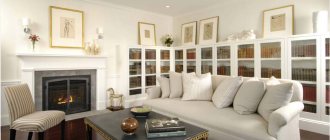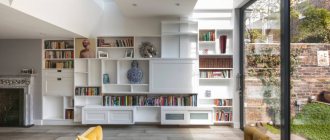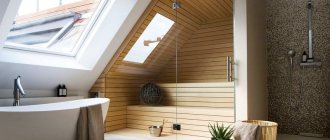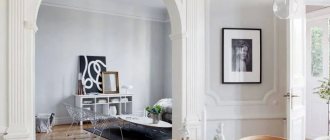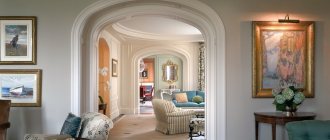The texture of natural materials fits organically into the design concept. Decorative stone in the interior is an effective, stylish decor. A wide range of textures and colors allows it to be used for rooms with different stylistic sounds. Imitation of natural stones will transform the interior and complement the solemn sound of classical and modern style.
Wide selection of stone for interior Source allcosmoshop.ru
Stone-like tiles for the fireplace Source www.oooarsenal.ru
Types of decorative stone and interior atmosphere
Modern technologies have made it possible to create analogues of natural stones at low cost. The materials are intended for use as decorative interior finishing. Types of decorative stone:
- Based on cement-concrete mixtures. Depending on the formulation, the composition contains the following components: cement, sand, reinforcing elements, various modifiers and plasticizers. The color palette is determined by coloring pigments. The textural variety depends on the geometry of the forms into which the solution is poured.
- An analogue of cement-concrete mixtures is gypsum. Production is organized according to a similar scheme. The gypsum base is suitable for creating a wide range of decor: brick, natural stone such as savage, sandstone.
- Artificial granite, marble (conglomerates - compounds). Up to 80% contain marble and granite chips obtained from crushed fractions of substandard residues of natural materials. The addition of binding resins, hardeners, and other reagents combines the mass into a durable monolith. In terms of technical characteristics, strength, resistance to mechanical and chemical influences, they are not inferior to natural analogues.
- Porcelain tiles. The mixture from which the tiles are made includes clay, silicates, and magnetic rocks (spars). Coloring pigments allow you to achieve the desired shade. High-temperature firing makes the material durable, resistant to mechanical stress and moisture. Porcelain tiles are an analogue of ceramic tiles with the addition of natural fillers.
- Composite - acrylic stone. Natural mineral fillers are bonded using acrylic resins. Dyes help achieve the desired shade.
Decorative slabs are smooth on the back side. A texture imitating natural material is applied to the outer surface. This shape makes installation easier.
Decorative stone in various stylistic directions
Natural materials, wood, stone, are organically integrated into a diverse style. Decorative artificial tiles make it possible to choose an imitation of natural materials at an affordable price. For example, natural polished marble is much more expensive than porcelain tiles.
Classicism
This category includes styles: baroque, antique, renaissance, neoclassicism and some others. All styles are united by the desire to recreate a richly decorated, solemn interior with a touch of pathos. Marble, polished granite, aventurine with mica inclusions are decorative companions for such interiors. The stone is mainly used to decorate fireplaces, columns, and wall panels. The main thing is to maintain balanced proportions between all the design elements of the room. Use the slab as a floor covering. Decorative marble-effect tiles are used in bathrooms.
Advantages of decorative stone
All types of artificial stone share these qualities:
- availability, relatively inexpensive finishing material;
- ease of installation;
- ease of care;
- resistance to mold, fire;
- durability (manufacturers provide a guarantee of at least 10 years);
- an impressive range of shades and textures.
If the stone is made of gypsum, clay, sand, then add to this list also environmental friendliness and hypoallergenicity.
Current colors
If we talk about trends and fashionable shades, blue is at the peak of popularity. This is probably due to the current palette, as well as the color of the year announced by the Pantone Institute. Shades of green and pink stones are also popular.
Instagram @charmestone
Instagram @charmestone
Color spectrum
There is a large number of color palettes for decorative stonework. Experts advise us to use this or that color depending on the parameters of the room: area, availability of lighting, busy interior. White color is the leader in use in narrow, small corridors, hallways, and bathrooms. It creates a visual increase in the room. Warm shades and grays work well in larger spaces along with wooden materials.
Necessary tools for DIY masonry
For DIY installation you will need many tools:
- spatulas - regular and serrated;
- metal tape measure;
- building level;
- rubber hammer;
- square;
- syringe gun;
- mixer for preparing glue;
- grinder with a disc for stone;
- brush or roller;
- brush with iron teeth;
- wooden block, beacons;
- containers for grout, glue;
- brush for smoothing seams,
- sprayer for water repellent,
- adhesive mixture.
Features of the use of artificial stone
Thanks to the variety of patterns and colors, decorative stone is a real “must have” for a modern interior.
Minimalism, if you use stone, becomes less bland, a Scandinavian interior becomes more diverse, eco-style and country style become more convincing, and a loft becomes much more comfortable.
Many ethnic styles are difficult to imagine without facing stone. For example, in a Mediterranean house this is a stylization of pebbles or boulders polished by the sea. In Alpine - under mountain debris. The interior is Provence-like, like sun-bleached sandstone. In English - under a strict cherry-colored brick. Artificial, glossy stone has made its way even into high-tech interiors, this “fiefdom” of metal and glass.
Stone is, of course, a unique tool for creating an extraordinary environment, but you shouldn’t go to all lengths. If you decorate the walls with stone tiles from top to bottom, you will get a crypt, a wine cellar, a dungeon... But not a living space.
Cladding with decorative stone solves several problems. Firstly, it is picturesque, elegant and prestigious. Secondly, with the help of stone you can delimit a room into functional zones, make it more voluminous and expressive.
National and ecological styles
Ethnic styles are very diverse, but several trends should be highlighted that attract natural stone.
The Scandinavian style was formed in harsh landscapes, rocky mountains and hills. Therefore, stone is a natural part of home design. Against the background of light walls, stone tiles look expressive. Use natural decorative textures in gray and yellow tones. Stone is present not only as decoration on walls and floor coverings - countertops are often made from it.
Japanese interior of a bright hall with decorative stone Source dd-restaurant.ru
A characteristic feature of Japanese minimalism is the desire to use natural materials and textures. Wood predominates in the interior; natural stone is used as a companion.
What textures are used in cladding?
Artificial or decorative stone in the interior of an apartment is:
- fashionable;
- exquisite;
- aristocratic;
- extravagantly;
- luxuriously;
- creative.
The most luxurious look is white stone in the interior or covered with enamel. It does not destroy the special atmosphere of the bedroom and perfectly sets off other finishing materials and textiles. It fits perfectly into most styles, regardless of texture. The best solution for a modern bedroom is with imitation white marble on top of a “warm floor” system. The wall cladding behind the head of the bed can be of any texture and not necessarily white.
For design purposes, sometimes a rough texture or contrasting finish is needed. This is used in urban and technological styles - loft, hi-tech or techno. Upholstered furniture of unusual shape requires a corresponding wall or panel. A spectacular backdrop behind a sofa or armchairs, lined with stone decor in a living room or large recreation area, looks very stylish.
Typically, decorative stone is used in hallways and corridors
The fireplace looks elegant against the background of a stone wall
Some people like it when decorating a living space with stone brings a special “wild” atmosphere. The room is more reminiscent of a deserted beach near a cliff, a stone grotto in the mountains, or a cave inhabited by modern city dwellers. In this case, a material with a texture close to the natural surface is used.
Photo wallpaper with a 3D effect, roughly processed wood and vertical landscaping - a wall with living plants - will give a special impression to the “wild nature” corner. Artificial stone in such an interior should imitate natural analogues as much as possible, the masonry should be uneven and a little chaotic. This is exactly what an eco-style room should look like - photo.
Decorating an apartment often involves the use of smooth polished pebbles (river or sea) or colored sea pebbles. An excellent way to use it is to lay out a mosaic pattern, and then paint some fragments. An excellent solution is to lay out pebbles on a kitchen splashback or a decorative panel in a living room.
Finishing the walls with decorative stone would be the right decision.
The wall decoration in the living room is made of decorative gray stone
Decorative stone in the living room will look chic
The use of rough textures has no restrictions for people with imagination and a creative approach to business. But sometimes this goes beyond reason, and luxurious decoration can look gloomy and uninviting for various reasons:
- too small room, narrow walls;
- the proportional limit of the stone texture of the floor and walls has been exceeded;
- different types of cladding are poorly arranged;
- The cladding does not match the style.
Designers prefer this type of room decoration for the special atmosphere of stone. Other materials do not have such a magical aura. But it should not be used as the main material, only as a spectacular decor.
Decorative stone is very durable and perfectly complements the design of the room
The right decision would be to decorate the walls in the kitchen with decorative stone
Regulatory styles
First of all, these include styles designed in the traditions of minimalism. Laconism, the use of strict geometric shapes, the absence of excessive decoration, simplicity of lines are the aesthetic principles of stylistics. Decorative stone in a minimalist interior looks more expressive. The absence of unnecessary details creates additional space for visual emphasis on the texture of the material.
Glossy stone tiles in the living room interior Source rumble.com
The slabs are used to highlight zones, as a fireplace finish. Individual structural elements, open plasterboard shelves, and partitions are emphasized.
Sandstone textures are mainly used; yellowish shades soften the “severity” of minimalism. The grayish-white tones of slate and shungite look good in the interior and harmonize with the overall style.
Smooth lappatted (non-slip) porcelain stoneware is suitable as a floor covering.
Room with a fireplace in a loft style Source pt.aviarydecor.com
The urban style of techno and hi-tech limits the use of decor; mainly modern composite materials are used. But inclusions of stone decor with textures of brick and savage stone naturally fit into techno and hi-tech styles.
Loft - eclectic (mixed) style. Originated in the first half of the 19th century. The bohemian intelligentsia of America reclaimed the premises of former factories, warehouses and attics as living quarters. Spacious rooms with brickwork, rubble and cobblestone textures are part of the natural ambiance of the loft, so stone decor is organic in this style.
Interior of a house in loft style Source mydesign-review.blogspot.com Living room with a decorative wall Source megastroyclub.ru
Homemade or organic styles
This stylistic direction is united by the desire to create an atmosphere of comfort. The functional content of the room plays an important role. Smooth contours, warm and pastel shades are needed to create an atmosphere of home comfort. The texture of natural stone naturally complements this interpretation.
These styles include Provence, grunge, country, chalet, shabby chic. The textures of natural stone in the form of lamellar slate, cobblestone, and sandstone are mainly used. Stone decor along with natural wood dominates the interior.
Beautiful veranda Source www.pinterest.ru
Beautiful big house Source www.dizain-moego-doma.ru
Stone cladding options
There are several facing options.
Corridor and hallway
Due to its wear resistance, practicality, easy care and presentable appearance, decorative stone is especially often found in the corridor or hallway.
Decorative stone in the living room interior
The stone is associated with reliability and safety. If it is present in the living room, the household members feel more confident, “like behind a stone wall.”
The stone is also associated with fire, with the warmth of the hearth. Man has carried the memory of the tandem of fire and stone from cave times; it is not for nothing that fireplaces are still covered with rubble and cuts today. However, not only fireplace portals are decorated with granite, brick or shell rock tiles.
Decorative stone is used to line niches with lighting, shelves, glass display cases, a fragment of a wall with a TV panel or behind a sofa.
Decorative stone, due to its structure, absorbs a lot of light. Therefore, designers advise alternating it with light plaster or wallpaper. Remember also that finishing with artificial stone will require additional lamps and a well-thought-out lighting scenario.
Decorative stone is especially good in a studio apartment. Perhaps this is the simplest, most budget-friendly, most relevant way to divide your home into locations.
Decorative stone in the bedroom
Here the stone will become a talisman: it will calm, lull, and bring back memories of something dear, truly natural.
A massive, high-quality bed is ideally combined with walls covered with decorative bricks, as well as with wooden beams, caissons, and sconces in the form of candelabra.
In the bedroom it is better not to use stone tiles with a glossy surface to avoid a “cold”, disturbing flicker. And don’t forget to highlight the fragment lined with stone with lamps, which will make the texture softer and warmer.
Usually the stone is used to decorate the wall behind the head of the bed or the corner with the dressing table and mirror. Unlike the hallway, where transitions from stone to plaster are made using torn edges and flows, other, less noticeable techniques are used in the bedroom. For example, they mark masonry with moldings.
Decorative stone in a children's room
The environmental friendliness and safety of artificial stone tiles ensured its entry here.
It is also important that with the help of a stone you can embody the plot of your favorite fairy tale. Let’s say, create a “princess castle”, “Ali Baba’s cave”, “dungeon of the gnomes”, “underwater grotto”.
With artificial pebbles it is easy to lay out a mosaic, a panel, paint the pebbles to look like snails and ladybugs, decorate a landscape on the wall with a frame of stones, or a niche with toys.
If we are talking about a teenager’s room, then artificial brickwork near the desk will discipline him and call him to order. And resonate with more adult toys - car models, a globe, things in the steampunk style.
Kitchen
The volume, naturalness and texture of this cladding will undoubtedly attract attention and give the kitchen or dining room a certain image.
Decorative stone in the bathroom
A natural pool carved into the rocks - this is what a bathroom decorated with stone tiles might look like.
In the bathroom, glazed stone that does not absorb moisture and porcelain tiles are used. As well as cast marble and onyx - composite materials made from stone chips, coloring pigments and polyester resins. The latter type of finishing is becoming increasingly popular because it looks like noble and valuable rocks - jasper, malachite, lapis lazuli, translucent onyx.
A part of the wall with an attached mirror, a recess in which candles are lit, a countertop above the sink, lined with glossy, purebred tiles, will transform and elevate the interior of a standard bathroom.
Balcony and loggia
Decorative stone will allow you to turn a balcony or loggia into a cozy relaxation place and create a more thoughtful design.
Examples of interior design with stone
Stonework looks especially good in areas where various equipment is located. For example, by decorating a wall with a TV, you can add a very original touch to the decor. To create a certain medieval era in the interior, you can use torn stone.
The photo shows an area with a TV, decorated with decorative white stone trim.
Decorative crushed stone with uneven edges will highlight certain interior areas or be an excellent solution for decorating a doorway, window or niche. With the help of stone slabs, imitation onyx or quartz with lighting softly flowing from within, it is possible to further emphasize its natural beauty.
Finishing technology and care
Ease of application on surfaces of complex shapes is an important advantage of soft stone; finishing with the material is in many ways reminiscent of the technology of gluing ordinary heavy wallpaper. The work is carried out in compliance with the following simple rules:
- The surface of the wall is carefully leveled: the plastic material can highlight defects.
How to decorate a bathroom Source dekormyhome.ru
- For gluing, special mixtures or glue are used, sometimes tile adhesive (wallpaper does not shrink). Before applying the glue, the wall is primed and allowed to dry.
Tile decoration Source steadicams.ru
- The canvas is glued in compliance with the correct direction of the texture. If the coating is applied to corners or curved surfaces, it is slightly heated with a hair dryer. Elasticity appears, and the fragment takes the desired shape.
- There is a protective film on the front surface of the tile (roll). It is recommended to remove it a day after installation to prevent glue from getting in.
In the interior of the hallway Source i5.photo.2gis.com
Caring for a surface made of flexible stone is not difficult. Dust is removed with a vacuum cleaner with a soft attachment, dirt is cleaned with a brush and water (you can add a little mild detergent). An acidic environment can damage the surface, but in residential areas there is no need to worry about this.
Flexible solution Source realstonegroup.kz
Combinations of stone with other finishing materials
The most harmonious combinations:
- Tree. This combination will give the design a special originality, combining rustic simplicity, industrial brutality and natural grace.
- Wallpaper. Decorative stone, due to its uniqueness, can be easily combined with any wallpaper or even photo wallpaper.
- Tile. An ideal duet, distinguished by naturalness and at the same time original creativity.
- Decorative plaster. It is a very successful tandem that always looks noble and elegant.
- Painting. This combination is a classic and most commonly used design solution.
The photo shows a decorative stone combined with photo wallpaper in the interior of a modern living room.
Various combinations will give the atmosphere a special historicity, add natural motifs to it and enhance the naturalness of the design.
What to consider before repair
The location, as well as the amount of colored stone in the decoration, directly depends on the lifestyle of the apartment owner. It is unlikely that marble walls will be relevant in a student’s apartment. If you have children, this is also important to consider. For example, it is better to cover a quartzite floor with an anti-slip compound to prevent running children from slipping. It is also important to take into account the activity of using the kitchen; even culinary preferences matter. For example, those who often fry meat on the stove can quickly ruin the coating with drops of fat and oil.
Instagram @leostone.official
Instagram @leostone.official
Instagram @leostone.official
Instagram @tssipiramida
Rules for selecting stone for finishing
Decorative stone has many advantages, including:
- Fire resistance;
- Safety from the point of view of household health;
- Wear resistance;
- Easy to maintain and clean;
- Large selection of shapes, palettes and textures.
In order to correctly combine all the positive properties and the external side of the material, you should clearly think in advance what exactly will be decorated with this material. And here it is important to consider the following factors:
- Price characteristics. Based on the available budget, the countdown of the main points begins;
- Weight. For certain walls and arches only light forms are required;
- Appearance. For every person, one or another texture, shape, color scheme is important;
- Strength. The kitchen space also requires moisture resistance; no one will change the lining every week.
How to care for natural stone
To prevent the stone from losing color and stains and chips appearing on the surface, it must be properly cared for.
- Avoid getting oil and grease on the surface as they can cause stains that are difficult to remove.
- Get into the habit of cleaning the surface regularly - at least once a week.
- If a stain appears, be careful when choosing cleaning products. Many common aerosols and gels can spoil the mineral.
- To completely restore the color and texture of the surface, you need to polish it every few months.
- Once or twice a year, mineral products need to be treated with a special protective compound. It leaves a thin film on the stone and provides additional protection from moisture, repels oil drops and grease.
- Use trivets, cutting boards and other protective accessories to help the original polish last longer.
Instagram @leostone.official
Instagram @leostone.official
Decorating room surfaces
- Walls
Walls with masonry are stylish and even strict. Who would have thought that stone could bring warmth, comfort and a finished look to the entire space. The first thing you need to do is choose the material itself: brick, cobblestone, river stone. It is also necessary to decide on the size: solid layers or small elements, what exactly will be displayed on the wall. There are many advantages to this decor: walls decorated with stone elements create additional insulation. And this is important, especially in the conditions of standard apartments. Such a wall seems to emerge from nature or a fairy tale, diluting the modern interior. It is necessary to think about proper lighting.
- Floor
Stone flooring has been popular for a long time. There is a wide range of finishing options. But there are also limitations: some types of material are quite fragile, they can easily be damaged by something sharp or careless movement. It will be completely unsafe to walk on it. An interesting option will turn out if you use pebbles in the shower, bathroom, or hallway. In the kitchen, such a covering will be very convenient.
- Fireplace
A fireplace trimmed with stone looks chic and elegant. A fireplace will create a cozy and fabulous atmosphere around you, where friends and family will want to gather. For many centuries in a row, finishing was done with brick. Its fire resistance ensured its popularity. Today, other materials are used, their properties are similar to the thermal properties of brick: tiles made of baked clay, porcelain stoneware, natural or artificial stone. All these finishing materials can withstand high temperatures and protect against the penetration of moisture and soot.
- Ladder
Another option that designers borrowed from the Middle Ages. The stone steps look as close to nature as possible. They are durable and will last for many years. This finish is used mainly in large houses and cottages. There is an option to use partial masonry, laying masonry over wooden layers. You can also use artificial stone. This will reduce costs
- Doors, arches, niches
Many interior elements can be decorated with stonework. The stone on both sides of the door will emphasize the informal atmosphere and style of the room, and will also draw attention to the canvas itself. Arches are often decorated with stone. In an ordinary interior, such an arch will focus attention and give a special charm to the room. A niche lined with stone can also serve as a decorative element. On its background you can place flowers, panels, paintings, TV. And all this will fit well into any interior style.
About composition and varieties
This decorative material was developed in Germany about ten years ago. It is known as flexible (or soft) stone, flexible sandstone, stone veneer or stone wallpaper, and is notable not only for its appearance, but also for its method of manufacture and use. The facing material consists of the following three layers:
- The basis. Special textile backing or non-woven fabric (agrocanvas).
- Adhesive substance. A polymer (acrylic), which has binding properties, fixes the outer layer and gives flexibility.
Imitation brickwork Source img.aviarydecor.com
- Decorative layer. Fine chips obtained from natural sandstone, quartz, marble or granite; does not crumble, does not fade or crack.
The flexibility of the material is ensured by the fact that a small gap is maintained between the crumb particles. Manufacturers offer the material in roll or tile format.
In interior design, tiles in formats from 200x300 to 950x1200 mm are in demand. The length of stone wallpaper varies between 2-4 m, the width varies within a meter.
Thickness of soft stone Source art-tse.by
TOP 7 best modern materials for imitation brick
Gypsum
The best material for stone finishing in the interior is artificial gypsum stone. This material not only has an affordable price, but also a huge number of mastered forms, light weight and easy installation. Gypsum decorative stone can be painted and also laid on plasterboard walls. It goes very well in the interior with wallpaper.
Decorative gypsum stonePros
- easy;
- simple installation;
- affordable price.
Minuses
- fragility;
- too sensitive to water.
Decorative brick-like plaster facing stone for interior decoration
Clinker
- high level of execution;
- resistance to mechanical stress;
- excellent performance characteristics.
Clinker refers to red clay tiles that have undergone severe heat treatment. As a rule, they are used not only for decorative decoration of walls in the hallway and kitchen, but also outside, as facade decoration.
Based on this, it is already possible to draw a very specific conclusion about how convincing clinker is in its characteristics:
- is not afraid of water or high/low temperatures;
- fireproof;
- absolutely non-toxic;
- easily fits into the most capricious interior.
The photo shows several options for decorating walls with such decorative stone in the hallway and in the kitchen - next to the wallpaper and without it.
Quartz
Quartz is not a completely artificial material: it consists of 90% natural stone. Synthetic resin connects minerals - this is the artificial part of quartz. Quartz slabs have excellent functional characteristics: they are strong and durable.
The quartz wall serves as an accent for a Japanese-style living room
Flexible stone
- easy-to-use material;
- high price;
- well suited for the design of non-linear surfaces.
An option that is rarely seen in modern interiors due to its high cost. However, the visual decorative effect fully justifies the material investment. And from the installation point of view, everything is very simple and understandable even for beginners.
Concrete
Concrete stone is an inexpensive and easy way to decorate. It is used for cladding walls in lofts and minimalist interiors. Slabs are made from sand, additives and plasticizers. It is mounted not only on walls, but also on the floor and ceiling. When laying, do not forget to use additives - this will make the structure stronger and more durable.
The concrete wall continues the theme of minimalism on the gray monochromatic kitchen
Acrylic
Acrylic stone decor is suitable for any style and room. This is a light, durable and beautiful material. Acrylic does not deteriorate under mechanical, thermal and water influences.
Thanks to the variety of shades and textures, acrylic stone decor will fit into any interior
Porcelain tiles
- very strong but heavy tiles;
- impeccable characteristics;
- unconvincing relief.
Porcelain stoneware is often confused with clinker, but there is a significant difference between them: porcelain stoneware is hardened at a higher temperature, its base is made of ceramic mixed with quartz sand.
In terms of characteristics, of course, there is complete parity: also universal use - and also absolute immunity even to strong mechanical influences.
However, in terms of conveying the features of stone texture, porcelain stoneware does not have many trump cards here. It does an excellent job of imitating marble rocks, but in everything related to volume and relief it is completely inferior to gypsum and clinker options.
Non-standard use
For those who believe that decorating a wall using decorative stone is too simple a solution, there are more daring proposals:
Decorating the ceiling This method allows you to achieve the effect of antiquity. Due to the right combination with interior items and decorative elements, you can create the feeling of a medieval castle or a rich old mansion. In this case, spot lighting looks advantageous;
Create the feeling of a medieval castle
Stone door An excellent option for disguising the door to an office or any other room. For this, decorative tiles with an appropriate pattern are used;
Concealed door
Niche made of textured material. An excellent solution for bedrooms, it creates the feeling that a person falls asleep in the most natural conditions. I love stone niches in living rooms, dining rooms and dens;
Decorating a stone niche for a bedroom - comfort and coziness are guaranteed
Winter garden You can't think of a better combination than flowers, stone and trees. Due to its technical properties, this material is excellent for interior decoration of a winter garden;
Winter Garden
Mirror framing This option will fit into any interior. The framing effect can also be used when working with aquariums, windows, paintings and various openings;
Combinations of stone and mirror
Creating decorative panels on the walls With the help of decorative stone, you can show your imagination and get extraordinary designs that will become an exceptional addition to your interior.
The panel on the wall made of stones looks beautiful
Types of natural stone for finishing walls inside an apartment
Natural finishing material is used infrequently - it has a high price. But it also has its advantages: long service life, reliability, resistance to mechanical stress.
In addition, it retains heat well inside the apartment.
Marble
Strength and durability are two main characteristics of marble. There are many colors that are easy to match any design. It is resistant to temperature changes and tolerates moisture well. The stone can be polished, giving a beautiful appearance and shine.
The work process has its own nuances: heat treatment, grinding, polishing.
Slate
One of the most successful options for finishing work is an environmentally friendly and reliable material. You can choose different colors: green, black, red, gray tones. The use of such a stone is a sign of good taste among apartment owners.
A room decorated with slate looks elegant and unusual.
Wild
Wild stone is often used in the interior of an apartment. This is a unique material - the color and texture are not repeated, so the room looks unusual. It is used for finishing fireplaces, walls, columns.
It is better to use the stone in doses, since your bedroom can turn into a primeval cave - it is characterized by natural roughness.
Granite
A good solution for any room - granite is moisture resistant, withstands sudden temperature changes, does not become dirty and does not wear off over time. There is a minus: background radiation, which is increased. To use it on a wall, it must be reinforced.
Granite is able to change colors when lighting changes; the edges shimmer in the sun.
Ural shale
The material has its own “zest” - it looks great both in processed and unprocessed form. The last option, due to the textured relief, brings a touch of pristineness to the interior. As a rule, Ural slate is used in the form of decorative tiles and decorated one of the walls to give the interior a brutal look. This unique stone allows you to create a sophisticated interior.
Stone veneer
It is a very interesting option for interior decoration. Essentially, this is the same wallpaper, only in the form of ultra-thin sections of natural stone from 1 to 3 mm thick, which are glued to the wall surface. Thanks to its elastic texture, this material has a wide range of applications, including finishing furniture and decor.
There is incredible scope for imagination here: the walls can be decorated with geometric panels, or translucent structures can be made from translucent stone veneer (onyx) with internal lighting.
Which stone to choose for the wall in the kitchen?
Stone walls will show themselves not only in dry rooms, but also in the kitchen. The interior is exposed to moisture, changing temperatures and various types of dirt, so it requires high-quality wall cladding. Granite, that is, a volcanic rock, will ideally serve as a decorative stone for a kitchen wall.
Granite is the hardest stone, resistant to abrasion. It is also insensitive to chemicals, so it can be used on kitchen countertops. Remember that granite is a heavy material, so it requires a strong foundation. Due to its resistance to moisture and abrasion, the stone is ideal for the kitchen between wall-mounted and standing cabinets.
Granite comes in different colors so you can easily integrate it into your interior design idea. You will find tiles in warm and cool shades. You can combine stone on your kitchen wall with a worktop made of the same material to create a space that is resistant to stains, moisture and damage.
Stone wall in the kitchen - what material to choose?
- Granite is ideal for the kitchen,
- The stone is characterized by hardness, abrasion resistance and resistance to cleaning agents,
- The raw materials are also resistant to moisture,
- You can apply it both to the countertop and to the wall between hanging and standing cabinets - this way you will get a uniform surface,
- Granite is available in various shades, such as brown or aqua.
Kitchen wall cladding can provide an elegant backdrop for a table area.
Photo gallery - even more ideas
In the photo selection below you will see how else you can use decorative stone in the interior. The gallery of images includes the most interesting design solutions for finishing stairs, niches and arches.
Sources
- https://m-strana.ru/design/sposoby-ispolzovaniya-dekorativnogo-kamnya-v-interere/
- https://ReHouz.info/dekorativnyj-kamen-v-interere-foto/
- https://www.InMyRoom.ru/posts/16103-dekorativnyj-kamen-v-interere-s-foto
- https://www.dizainvfoto.ru/dekor/dekorativnyj-kamen-v-interere-vse-sekrety-izyskannoj-otdelki.html
- https://design-homes.ru/idei-dlya-doma/ispolzovanie-kamnya-v-interere-kvartiry-vidy-sochetaniya-65-foto
- https://stroyday.ru/remont-kvartiry/steny-i-potolok/iskusstvennyj-kamen-v-interere.html
- https://ars.ru/vnutrennyaya-otdelka-pod-kamen-v-raznyh-komnatah/
- https://J.Etagi.com/ps/otdelka-dekorativnym-kamnem/
- https://www.ivd.ru/dizajn-i-dekor/dekorirovanie/7-tipov-iskusstvennogo-i-naturalnogo-kamnya-i-nyuansy-ih-ispolzovaniya-v-interere-35451
- https://Trizio.ru/dekorativniy-kamen-v-interere-foto-20
